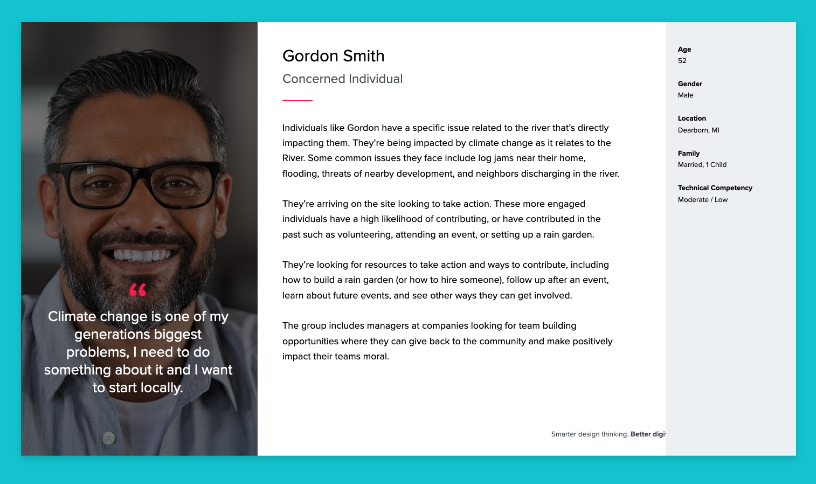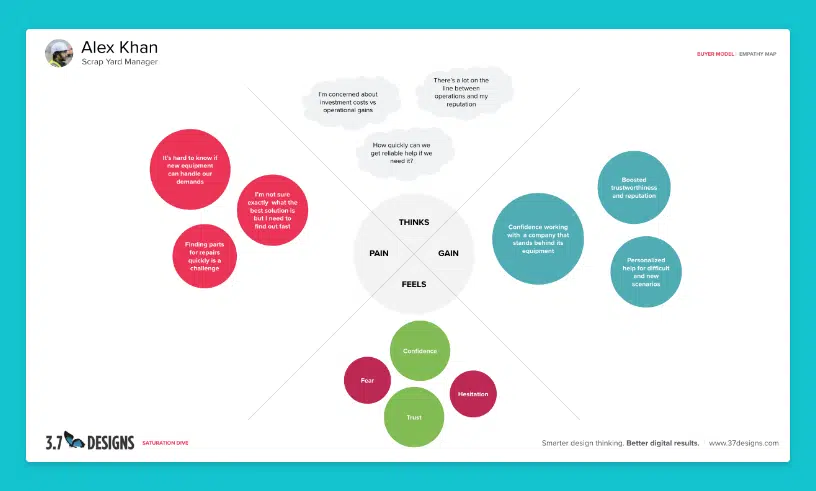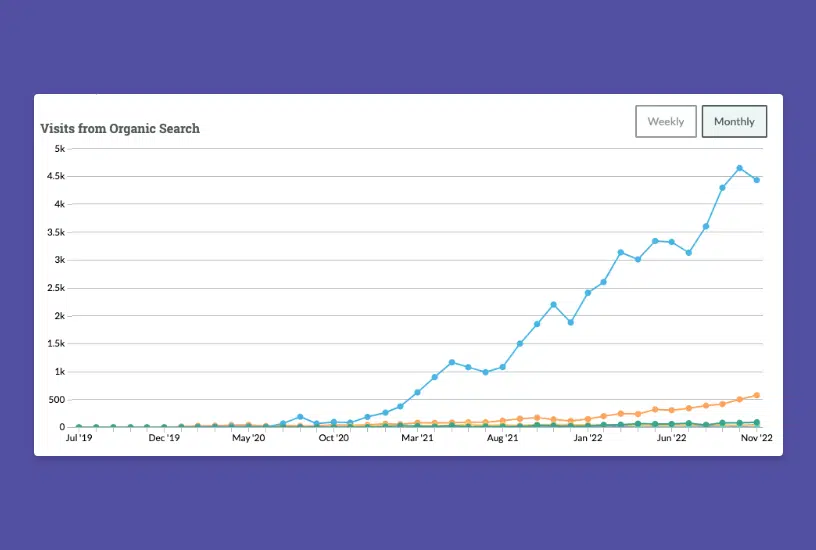Generating Top-Tier B2B Organic Leads: Your Complete Roadmap

Maximize your organic lead generation strategy with expert digital marketing insights.
In today’s competitive digital landscape, generating organic leads is crucial to every successful B2B marketing strategy. But what exactly are organic leads, and why are they beneficial for businesses?
In this article by 3.7 Designs, we will explore the world of organic leads, understand their advantages, and learn how to create a robust digital marketing campaign to attract high-quality organic leads.
What Are Organic Leads?
Organic leads represent potential customers who learn about your business through unpaid channels such as search engines, social media, or word-of-mouth referrals.
Unlike leads generated through paid advertisements or cold outreach, organic leads find your business through natural or “organic” means — often because they recognize the value you offer or find your content highly relevant to their needs.
The Benefits of Organic Leads for B2B Companies
Organic leads are a powerful asset for any business because they connect you with potential customers actively seeking out the solutions or information you offer. In today’s digital era, focusing on organic lead generation can yield numerous advantages for your brand.
Organic leads are particularly valuable for B2B companies due to their high average sale value, customer lifetime value, and long buying cycles. For B2B businesses, it’s worth the investment in cultivating organic leads because the ROI is higher, and you often need multiple touchpoints with your prospects before they’re ready for a sales conversation.
Let’s explore the key benefits of generating organic leads for B2B companies through digital marketing:
Higher Quality Leads and More Trust
Organic search visibility allows you to establish credibility and trust early on in the buyer’s journey. As you offer valuable information and advice, your prospects build a relationship with your brand even before they convert. B2B companies that leverage content marketing for organic leads have conversion rates six times higher on average than competitors.
Increased Brand Awareness
Consistently offering valuable and relevant content establishes you as an industry expert. Each piece of content increases the chances of your target audience encountering your brand. With enough touchpoints—eight on average—prospects will become familiar with your brand and are more likely to refer or contact you when needed.
55% of B2B buyers use social media to research potential solutions
Additionally, valuable content can enhance brand awareness when shared on industry publications or social media. Creating content worth sharing helps you reach a broader audience and expand your influence. 55% of B2B buyers use social media to research potential solutions in the early stages of the buying process.
Long-Term Return on Investment
Organic lead-generation strategies like content marketing and SEO are ideal for long-term ROI. Organic efforts compound over time as more content is published and gains visibility, continually generating more leads and sales. While paid lead generation campaigns can be effective in the B2B space, once the budget is spent the campaigns no longer deliver.
Audience Insights
Publishing organic content provides valuable insights into your target audience’s interests and behaviors. By monitoring which content they search for, engage with, and take action on, you can identify their pain points and preferences. This customer data is instrumental in refining your overall marketing strategy and generating ideas for more targeted content.
This process creates a marketing “flywheel,” where content production leads to better audience understanding, which informs the creation of more relevant content, which attracts more of your target audience. The process repeats, continually optimizing your marketing efforts.
Higher Close Rates
Approximately 62% of B2B buyers prefer content that provides practical information, like case studies and user reviews. Creating value, relevance, and high-quality content builds trust with your target audience, making them more likely to close. This has been demonstrated through a survey by Qualified that determined that 73% of B2B buyers cite brand trust as the most influential factor when choosing a vendor.
Increased Sales
When your brand consistently appears in search results, it reaches a broader audience and establishes trust and authority in your industry. Consequently, the leads generated through organic search are often more engaged and ready to convert, driving sustainable growth and profitability for your business.
Why Digital Marketing is Effective in Generating B2B Organic Leads
Content marketing and SEO have additional benefits that leadership and stakeholders value.
Targeted and Data-Driven
Digital marketing allows B2B businesses to precisely target their ideal audience based on demographics, interests, behavior, and other relevant data. This targeting ensures that your content reaches the right people genuinely interested in your offerings, increasing the likelihood of lead conversion.
The old saying, “Half of all marketing dollars are wasted; I just don’t know which half,” doesn’t apply to digital marketing. With tools like Google Analytics, HubSpot, and HotJar, you can track overall behavior, known prospects’ behavior, scroll depth, click behavior, and even video recordings of user interactions. You can also measure which social posts generated the most impressions, clicks, and sales. You can determine the exact ROI of a single piece of content.
Suppose you want to take your data-driven approach to the next level. In that case, you can leverage platforms like VWO to run A/B or multi-variant tests on your website to determine precisely what messaging, imagery, content, and layouts drive the most action. We have seen instances where switching the word “Your” to “My” in a call to action increased the conversion rate by nearly 200%.
Scalable and Flexible
Digital marketing strategies are highly adaptable, making them suitable for businesses of all sizes. Whether a startup or an established enterprise, you can customize your marketing efforts to align perfectly with your goals and budget.
Digital marketing’s flexibility allows you to adjust campaigns in real time, responding to market changes, customer feedback, and emerging trends. You’re not locked into long-term media contracts that prevent you from adjusting targeting, spending, or ad creative.
How To Create a Digital Marketing Campaign that Generates B2B Organic Leads
Generating organic leads through digital marketing requires a well-planned and executed campaign. Follow these essential steps to create an effective digital marketing strategy that attracts and engages your target audience.
1. Determine Your Goals and KPIs

Establishing meaningful Key Performance Indicators (KPIs) is a critical first step for any lead gen campaign. KPIs provide a clear picture of success. By defining specific, measurable goals, you can objectively determine whether your campaign performs in real-time.
Regularly reviewing KPIs allows you to spot trends, identify areas for improvement, and make data-driven decisions. If you can’t identify what is working and what isn’t, you can’t adjust your strategies to maximize effectiveness and ROI.
Finally, KPIs are necessary for benchmarking and reporting. You can compare your campaign’s performance to industry standards or past performance with KPIs. You can generate clear, concise reports to keep stakeholders informed and manage expectations.
2. Perform Audience Research

You’re essentially shooting in the dark if you don’t understand your target audience. You don’t know where to reach them, why or why not they would buy your solution, or what to tell them to get them interested. In short, without a clear understanding of your audience, your campaign will likely produce subpar results. Traditionally, you’d create buyer personas. However, we recommend going deeper and creating “Buyer Models.”
Buyer models are more in-depth than traditional personas, providing deeper insights into their emotions, motivations, fears, aspirations, and experiences. The primary components of a buyer modal are:
Job to be Done Statement
A “job to be done” (JTBD) statement is a framework that helps you understand the underlying motivations and specific tasks your prospects want to accomplish when using your product or service. JTBD statements focus on the functional, emotional, and social needs driving behavior. You can develop more targeted strategies and messages that address your customers’ problems by identifying and articulating these jobs. This approach ensures that your marketing efforts resonate deeply with customers by aligning with their needs and desired outcomes.
JTBD statements are typically structured in the following format:
As a {role}, I need {specific solution} so I can {accomplish goal} to accomplish {desired outcome.}
For example:
As an IT manager at a mid-sized enterprise, I need a reliable cloud storage solution that integrates seamlessly with our existing systems, so I can ensure data security, improve accessibility for remote employees, and reduce downtime associated with data retrieval.
Emotional Drivers
Emotional drivers augment Jobs to Be Done Statements by documenting the specific emotions influencing your prospect’s actions and decisions. Emotion highly influences human behavior, which we later justified using logic. When you understand your buyer’s emotional drivers, you can tailor your messaging to resonate with their feelings and better influence them to take action.
We segment emotional motivators into internal, external, and social categories.
Internal Motivators
Internal motivators are personal reasons that drive behavior. For example, will a successful initiative increase their self-worth? Do they believe in their company’s mission, and does supporting it give them a sense of purpose? Are they worried about job security and where succeeding will provide them with safety?
Notice that all of these examples show how the prospect feels about themselves.
External Motivators
External motivators are outside factors influencing a prospect’s actions. Examples could be increased pressure from leadership, performance review goals, and increasing competition. While there are often corresponding internal motivations, such as fear of job loss, it’s worth identifying the outside pressures separately.
Social Motivators
Social motivators are related to interpersonal relationships and social status. Humans are an extremely social species. For hundreds of years, being separated from your group would mean certain death; as a result, how you feel about your status within your circle subconsciously drives much of your behavior. Examples include the desire for acceptance, pursuit of higher social status, and aspiring to be part of a community.
Empathy Map
An empathy map is a collaborative tool to gain deeper insights into customers’ thoughts, feelings, and behaviors. It helps marketers and designers understand the experiences of their target audience by categorizing their knowledge into four quadrants: what the customer says, thinks, does, and feels. This visual representation facilitates a more nuanced view of customer personas, ensuring that marketing strategies resonate more effectively with the target audience’s real needs and emotions.

Logic Map
Empathy maps focus more on feelings and actions, while logic maps focus on thought processes. Typically, a logic map documents common questions, objections, challenges, goals, triggers, and decision criteria. By having a logic and empathy map, you can understand the subconscious influencers and how your prospect interprets them logically, allowing you to address their thoughts, questions, and concerns before a sales conversation.
Buyer Journey Map
The buyer journey refers to the process a potential customer goes through, from the initial awareness of a need or problem to the final decision to purchase a product or service. It typically includes three stages: awareness, consideration, and decision. We often work with B2B businesses that only market for the decision stage, meaning they’re missing out on 2/3rds of the prospects still in the early stages of research. By mapping your buyer journeys, you can understand how and when to reach them at each stage and the messaging required to nurture them.

Buyer Story
You have one final step after you’ve documented your buyer’s JTBD statements, emotional drivers, empathy and logic maps, and their buyer’s journey– creating a buyer story. Buyer stories are narratives that humanize your functional buyer, giving them a name, back story, demographics, interests, and a photo. Buyer stories make it easier to empathize with your buyers and prevent decision-making based on personal preferences and anecdotes.
3. Curate a Content Strategy That Drives Organic Leads

Armed with a deep understanding of your audience, you can craft a content strategy that resonates with and connects with them at the ideal stages of their buyer journey. You’ll be able to reach more of your audience, reach them earlier, and convert more of them along the way.
We have a proven four-component system for building a content strategy that connects with your audience and builds search engine visibility.
The components are pillar topics, detail topics, and long-form content. Once you have gathered valuable insights about your audience, it’s time to craft a robust content strategy that resonates with them and drives organic lead generation.
Pillar Topics
Pillar topics are broad topics that align with your business and audience interests. They serve as the foundation of your content plan, as every piece of content will be a derivative of a pillar. Ideally, you should limit your pillars to 4 – 6 core topics; any more, and your efforts will be spread thin.

If your company sells software to automotive engineers, your pillar topics might include automotive software solutions, vehicle design and simulation, compliance, and new technologies.
Detail Topics
With the pillars established, you now break each pillar into subtopics. Each piece of content will branch off of these detailed topics. To use our previous example of vehicle design and simulation as a pillar topic, the detailed topics could be Advanced simulation techniques, software tools for vehicle design, and real-world simulation applications in automotive engineering.
Long Form Content
Creating valuable content is resource-intensive, especially if you don’t approach it strategically. We recommend focusing on creating long-form content that can be split up and repurposed rather than making lots of smaller individual pieces of content. Hosting a single webinar can be repurposed into a dozen pieces of content, including blog posts, video snippets, content offers, email content, and social posts.
At this stage, identify 3 – 5 pieces of long-form content for each detail topic. Examples of long-form include comprehensive guides, whitepapers, e-books, webinars, online courses, and long-form videos.
4. Amplify the Impact of Your Impact: The Art of Repurposing
Repurposing your long-form content is a strategic way to extend its reach and maximize its impact. By transforming your comprehensive guides, e-books, or whitepapers into various formats, you can cater to different audience preferences and increase organic lead generation. Repurpose content into the form of:
- Landing Pages: Create dedicated landing pages for lead capture related to specific long-form content.
- Blog Posts: Extract critical insights from your long-form content to create blog posts and engage your audience with informative articles.
- Content Offers: Use your long-form content as content upgrades or free downloads to entice visitors to provide their contact information.
- Social Media Posts: Create teaser snippets or infographics from your long-form content to share on social media platforms.
- E-mails: Use excerpts or summaries from your long-form content in email campaigns to nurture leads.
5. Unleash Your Content’s Potential: The Power of Promotion
Promoting your content ensures it reaches a broader audience and generates organic leads. By strategically disseminating your valuable content across various channels, you can attract the attention of potential customers and position your brand as a trusted industry resource.
Here are effective methods to promote your content:
- Ideal Channels: Share your content on appropriate social media platforms, your website’s blog, and your email newsletter.
- Guest Post on Other Websites: Collaborate with industry-related websites and platforms to extend your reach and tap into new audiences.
- Web Communities: Engage with online communities relevant to your niche and share valuable content with members.
Promote your content using various tactics, including publishing it on your website, creating gated content offers to capture leads, posting on social media, creating guest posts on other sites, and sending content to your email list.
Unlock the Power of B2B Organic Leads With Digital Marketing
By attracting high-quality leads through natural channels, you can establish trust with your audience, build a strong brand presence, and drive consistent conversions.
Experience the power of digital marketing and watch your organic leads grow, taking your business to new heights of success.
Need assistance in crafting a robust digital marketing campaign? Contact 3.7 Designs for expert guidance and support from our team of B2B marketing professionals. Let us help you achieve your goals and excel in the digital realm.